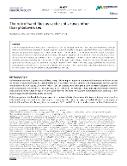The role of sand flies as vectors of viruses other than phleboviruses

Publication date
2023Published in
Journal of General VirologyVolume / Issue
104 (4)ISBN / ISSN
ISSN: 0022-1317Metadata
Show full item recordCollections
This publication has a published version with DOI 10.1099/jgv.0.001837
Abstract
Sand flies (Diptera: Phlebotominae) are proven vectors of various pathogens of medical and veterinary importance. Although mostly known for their pivotal role in the transmission of parasitic protists of the genus Leishmania that cause leishmaniases, they are also proven or suspected vectors of many arboviruses, some of which threaten human and animal health, causing disorders such as human encephalitis (Chandipura virus) or serious diseases of domestic animals (vesicular stomatitis viruses). We reviewed the literature to summarize the current published information on viruses detected in or isolated from phlebotomine sand flies, excluding the family Phenuiviridae with the genus Phlebovirus, as these have been well investigated and up-to-date reviews are available. Sand fly-borne viruses from four other families (Rhabdoviridae, Flaviviridae, Reoviridae and Peribunyaviridae) and one unclassified group (Negevirus) are reviewed for the first time regarding their distribution in nature, host and vector specificity, and potential natural transmission cycles.
Keywords
sand fly, sand fly-borne virus, Vesiculovirus, Curiovirus, Sripuvirus, Arurhavirus, Flavivirus, Orbivirus, Pacuvirus, Orthobunyavirus, arbovirus
Permanent link
https://hdl.handle.net/20.500.14178/1837License
Full text of this result is licensed under: Creative Commons Uveďte původ 4.0 International







